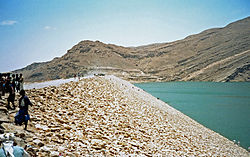- Marib Dam
-
The Marib or Ma'rib or Ma'arib Dam (Arabic: سد مأرب) blocks the Wadi Adhanah (also Dhana or Adhana) in the valley of Dhana in the Balaq Hills, Yemen. The current dam is close to the ruins of the Great Dam of Marib, dating from around the eighth century BC.[1] It was one of the engineering wonders of the ancient world and a central part of the south Arabian civilization around Marib.
Contents
The Great Dam of Marib
The site of the great Dam of Marib (Sudd Marib) is upstream (south-west) of the ancient city of Marib, once the capital of the Kingdom of Saba'a, believed to be the kingdom of the legendary Queen of Sheba. The Kingdom of Saba'a was a prosperous trading nation, with control of the frankincense and spice routes in Arabia and Abyssinia. The Sabaens built the dam to capture the periodic monsoon rains which falls on the nearby mountains and so irrigate the land around the city.
Recent archaeological findings suggest that simple earth dams and a canal network were constructed as far back as 2000 BC. The building of the first Marib dam began somewhere between 1750 BC and 1700 BC.[2]
The Makrib Ali Yanouf Bin Dhamar Ali (c. 790 BC) had his name carved into parts of the dam to mark the completion\reparation of the dam. The dam was of packed earth, triangular in cross section, 580 m in length and 4 metres high. It ran between two groups of rocks on either side of the river and was linked to the rock with substantial stonework. The dam's position allowed for a spillway and sluices between the northern end of the dam and the cliffs to the west. Around 500 BC the dam height was increased to 7 metres, the upstream slope (the water face) was reinforced with a cover of stones, and irrigation was extended to include the southern side as well as the northern side.
After the end of the Kingdom of Sheba, possession of the dam came to the Himyarites in around 115 BC. They undertook a further reconstruction, creating a structure 14 metres high with extensive water works at both the northern and southern ends - with five spillway channels, two masonry-reinforced sluices, a settling pond, and a 1000 metre canal to a distribution tank. These extensive works were not actually finalised until 325 AD and allowed the irrigation of 25,000 acres (100 km²).
Despite the increases in height, the dam suffered numerous breaches (recorded major incidents occurred in 449, 450, 542 and 548) and the maintenance work became increasingly onerous; the last recorded repairs took place in 557. In 570 or 575, the dam was again overtopped, and this time left unrepaired. The final destruction of the dam is noted in the Qur'an and the consequent failure of the irrigation system provoked the migration of up to 50,000 people.
The current dam
In 1986 a new 38 m high, 763 m long, earth dam was completed across the Wadi Dhana, creating a storage capacity of 398 million cubic metres. The dam site is located 3 km upstream of the ruins of the old Marib dam. The new dam was designed to store water for irrigating the Marib plains.
The current dam was financed by UAE founder Sheikh Zayed, whose tribe resettled from Marib to current UAE in about 17th century.
References
- ^ chp 2 Donald Routledge Hill, A history of engineering in classical and medieval times Routledge, 1996
- ^ Ocean highways: geographical record, ed. C.R. Markham. Ocean highways; geographical review. Vol. 1
- Notes
- A Study of the Marib Dam and Its Sluice System (115 B.C. - 575 A.D.)
- Link to Ancient Marib Dam on Google Maps
Bibliography
- Alessandro de Maigret. Arabia Felix, translated Rebecca Thompson. London: Stacey International, 2002. ISBN 1-900988-07-0
- Andrey Korotayev. Ancient Yemen. Oxford: Oxford University Press, 1995. ISBN 0-19-922237-1.
Categories:- Arabic architecture
- History of Yemen
- Archaeological sites in Yemen
- Dams in Yemen
- Dam disasters
Wikimedia Foundation. 2010.

